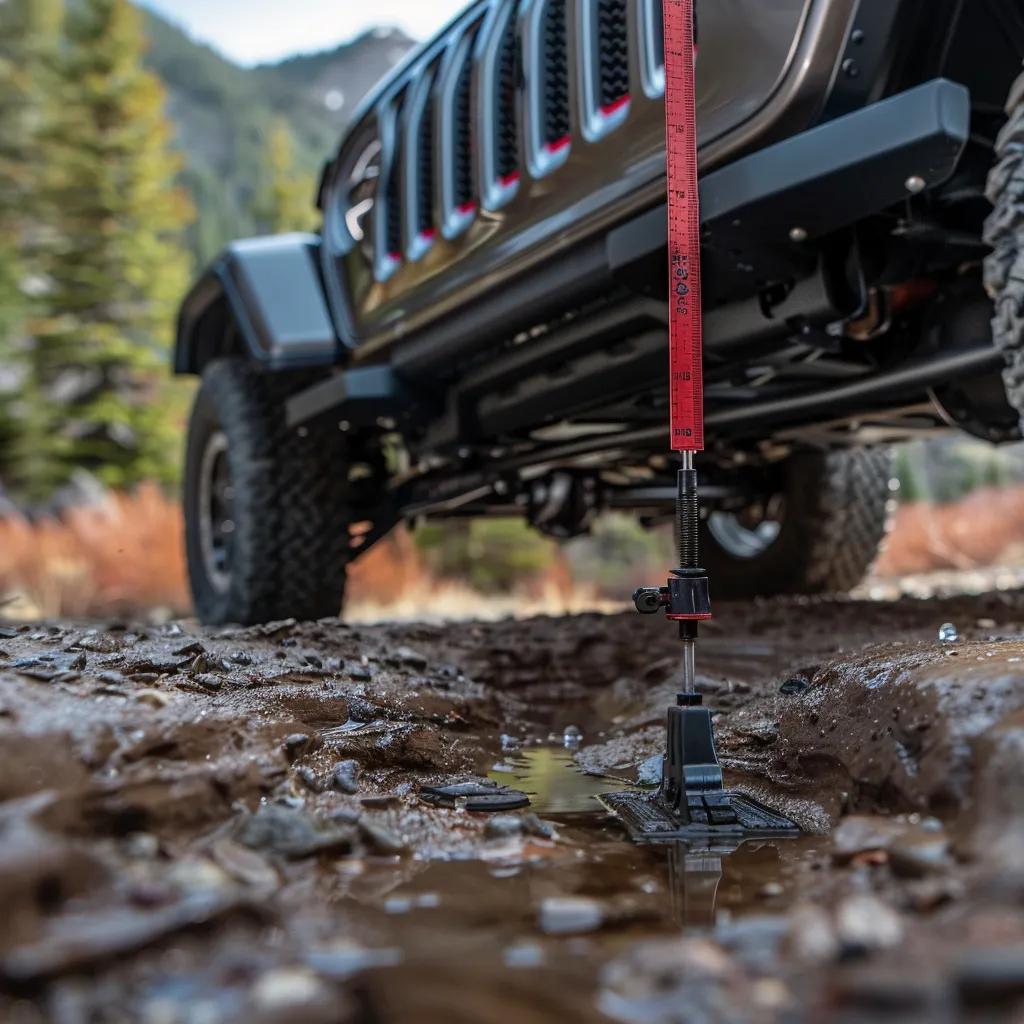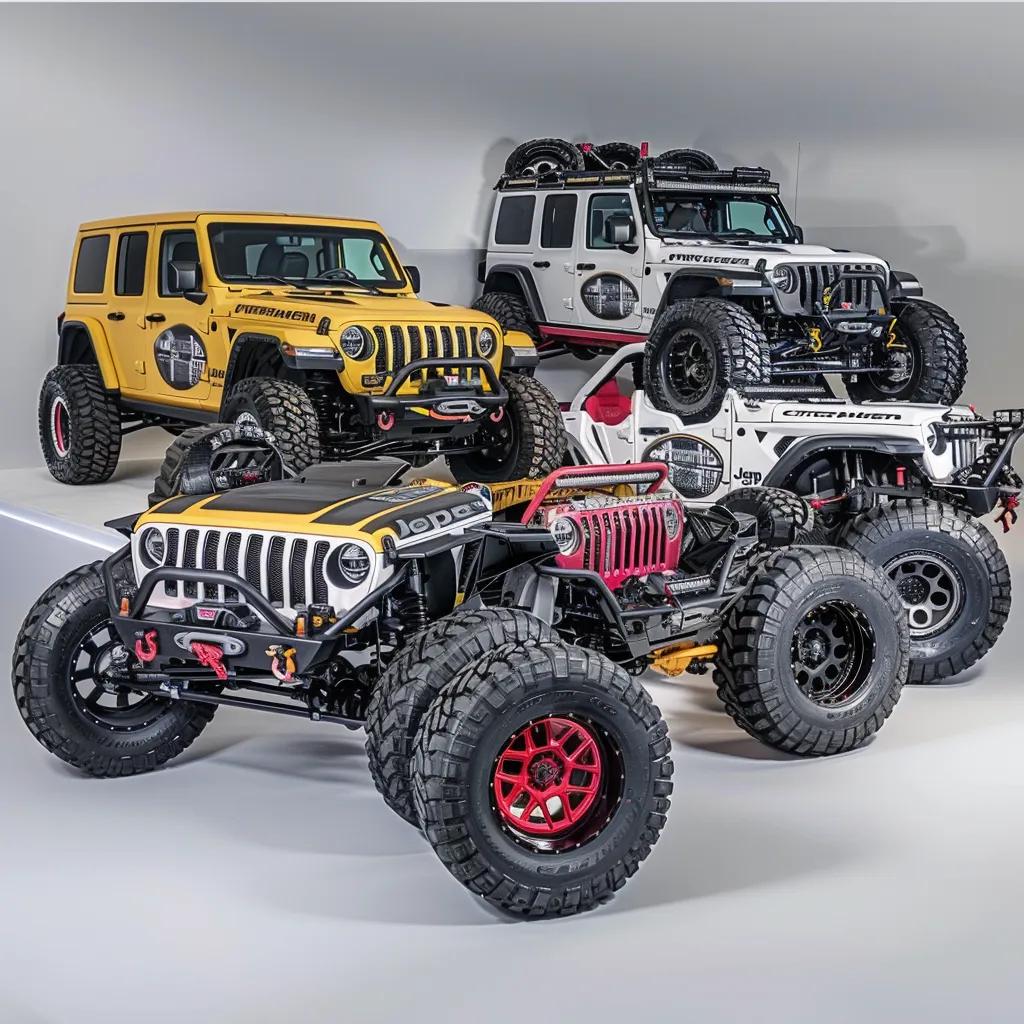
Table of Contents
Jeep Wrangler Ground Clearance: What You Need to Know for Off-Roading
The Jeep Wrangler’s ground clearance defines its ability to conquer rugged terrain without damaging critical components, and mastering this measurement can transform your off-road adventures. In this guide, you’ll discover what ground clearance is, how it’s measured on various Wrangler trims, and why it matters when tackling rocks, mud, and steep inclines. We’ll compare Sport, Sahara, Rubicon, Willys, 4xe, and 392 models, explain approach, departure, and breakover angles, outline proven lift-kit and tire upgrades, weigh stability and efficiency trade-offs, explore undercarriage protection strategies, and show you how to select the perfect clearance profile for your off-road style. By the end, you’ll have the knowledge to fine-tune your Wrangler’s height and armor for maximum capability and confidence on any trail.
What Is Ground Clearance and Why Is It Crucial for Jeep Wrangler Off-Roading?
Ground clearance is defined as the minimum distance between a vehicle’s underbody and the ground, and it determines how high obstacles can be before contacting the chassis.
Ground Clearance Definition
Ground clearance is the minimum distance between a vehicle’s underbody and the ground, determining the height of obstacles it can clear. This measurement is crucial for off-roading, influencing a vehicle’s ability to avoid damage and traverse uneven terrain.
Jeep, Jeep Wrangler Owner’s Manual
This definition is fundamental to understanding the article’s discussion of off-road capability.
This measurement directly influences a Wrangler’s ability to avoid rock strikes, navigate ledges, and traverse uneven surfaces without scraping vital components. For instance, a Rubicon’s 10.8-inch factory clearance lets it roll over medium boulders that would trap lower SUVs. Understanding this metric forms the foundation for all off-road geometry considerations and unlocks safer trail performance.
Measuring ground clearance begins at the lowest fixed point—often the differential housing or skid plate edge—and extends vertically to the ground. Accurate measurement ensures realistic expectations on trail obstacles and informs choices about tires, lift kits, and underbody armor. Recognizing how clearance interacts with angles, suspension design, and undercarriage protection lets you optimize every inch for specific terrain challenges. Next, we’ll examine the exact methods used to calculate clearance on your Jeep Wrangler.
How Is Ground Clearance Measured on a Jeep Wrangler?

Ground clearance measurement focuses on the chassis’s lowest permanent part, typically the front differential cover or skid plate lip.
- Position the Wrangler on a level surface with tires at normal pressure.
- Identify the lowest fixed point under the vehicle—avoid loose skid plates or tow hooks.
- Use a straightedge or laser gauge to measure the perpendicular distance from that point to the ground.
Accurate measurement prevents underestimating clearance, which can lead to unexpected scrapes or suspension damage. Clear data here feeds into lift-kit planning and tire sizing decisions in later sections.
Why Does Ground Clearance Matter for Off-Road Terrain?
High ground clearance enables a Wrangler to surmount rocks, stumps, and washouts without contacting the frame or drivetrain. It reduces the risk of underbody damage that can lead to fluid leaks or bent axles. Greater height also improves water-fording capability by lifting critical components above creek crossings. As clearance increases, approach, departure, and breakover angles expand, granting smoother transitions over crests and descents. Mastering this relationship is essential before modifying your Wrangler’s suspension or wheel size.
What Are the Risks of Insufficient Ground Clearance?
Insufficient clearance can result in undercarriage impacts that damage oil pans, fuel tanks, and differentials. Scraped skid plates lose protective function, leaving drivetrain components vulnerable. A low-ridden Wrangler may get high-centered on ridges or logs, halting progress and requiring recovery. In rocky sections, lack of clearance can deflect control arms or tie-rod ends, compounding repair costs. Avoiding these pitfalls begins with matching stock or modified clearance to the trails you intend to master.
How Does Jeep Wrangler Ground Clearance Vary by Model and Trim?
Jeep Wrangler ground clearance changes with trim-specific suspension setups, wheel sizes, and skid plate configurations. Comparing these factory specifications helps you choose the right model for your off-road ambitions and plan upgrades with precision.
Each spec reflects a balance of ride height, suspension travel, and component protection. The next step breaks down Rubicon’s clearance in detail and shows how Sport compares.
What Is the Ground Clearance of the Jeep Wrangler Rubicon?
Rubicon Ground Clearance
The Jeep Wrangler Rubicon features 10.8 inches of ground clearance due to its Rock-Trac 4×4 system and off-road-tuned suspension. Reinforced skid plates further protect the undercarriage from damage when navigating challenging terrain.
Jeep, Jeep Wrangler Rubicon Specifications (2024)
This specification highlights the Rubicon’s design for off-road performance, which is a key point in the article.
Reinforced skid plates under the transfer case and differential ensure those nearly 11 inches remain free of damage when cresting rocks. This height provides an ideal platform for aggressive wheel-and-tire combinations without compromising factory geometry.
How Does the Sport Trim’s Ground Clearance Compare?
Sport models offer 9.7 inches of clearance, which suits light off-road use such as fire roads and gravel trails. While adequate for mild terrain, this height limits boulder hopping and deep mud pits. A modest 1-inch lift or all-terrain tire upgrade can bring Sport models closer to Sahara-level performance without breaking the bank.
What Are the Ground Clearance Specs for Sahara, Willys, 4xe, and 392 Models?
- Sahara’s 10.3 inches come from larger 18-inch wheels and protective skid coverage.
- Willys matches Sahara at 10.3 inches but adds heavy-duty shocks for extra articulation.
- The electrified 4xe holds 10.3 inches under its battery skid but benefits from immediate torque for obstacle negotiation.
- The performance-oriented 392 uses 20-inch wheels and tuned springs to achieve 11.1 inches, prioritizing both height and handling.
Knowing these differences streamlines decisions about which model best fits aggressive trails, moderate paths, or electric-hybrid experimentation.
How Do Model Year Changes Affect Ground Clearance?
Jeep tweaks ground clearance across generations through suspension refinements, wheel-and-tire packages, and cosmetic lift elements. Recent 2024 updates introduce factory Xtreme Recon packages on Rubicon X models, boosting clearance up to 12.9 inches by combining a 2-inch lift with 35-inch tires. Recognizing generational lifts and option-package effects prevents surprises when ordering new Wranglers or buying used models.
What Are Approach, Departure, and Breakover Angles and How Do They Relate to Ground Clearance?
Approach, departure, and breakover angles describe how a Wrangler handles sloped surfaces without contact. These geometric metrics directly stem from ground clearance and wheelbase proportions.
What Is the Approach Angle and Why Is It Important?
- A Rubicon’s 44-degree approach angle clears large rocks and steep ledges.
- Higher approach angles prevent bumper scrapes when climbing into rough terrain.
Improving this angle often involves lift kits or trimmed bumper edges.
How Does the Departure Angle Affect Off-Road Performance?
- At 37 degrees on a Rubicon, the Wrangler avoids rear-end strikes on downhill drop-offs.
- A superior departure angle maintains traction and prevents rear differential damage when exiting ledges.
What Is the Breakover Angle and How Does It Prevent High-Centering?
- A Rubicon’s 27.8-degree breakover angle helps it clear ridges and crest humps without pinning the frame.
- Higher breakover angles reduce the chance of getting stuck on sharp ridges.
How Do These Angles Vary Across Jeep Wrangler Trims?
How Can You Increase Your Jeep Wrangler’s Ground Clearance for Better Off-Roading?
Raising a Wrangler’s clearance combines suspension lift kits, larger tires, or both to unlock higher angles and obstacle clearance on demanding trails.
How Do Suspension Lift Kits Improve Ground Clearance?
- A 2-inch coil-spring lift raises the axle housing and frame rails, providing extra room for larger tires.
- Long-arm kits improve suspension articulation, maintaining ride quality despite higher stance.
- Body lifts separate the body from the frame without altering suspension geometry, adding 1–2 inches clearance.
What Role Do Larger Tires Play in Increasing Clearance?
- A move from 32-inch to 35-inch tires adds roughly 1.5 inches of lift.
- Aggressive tread patterns improve traction on loose surfaces while lifting the chassis.
- Proper wheel backspacing ensures tires clear control arms and fenders.
What Are the Best Lift Kits and Tires for Jeep Wrangler Ground Clearance?

How Do Lift Kits and Tires Affect Off-Road Angles?
Lift Kits and Off-Road Angles
Increasing lift and tire size raises approach, departure, and breakover angles proportionally, enhancing off-road performance. A 2-inch lift with 35-inch tires can significantly improve these angles, leading to safer and more capable off-road experiences.
Off-Road.com, Lift Kit Guide (2023)
This information supports the article’s discussion on how to improve ground clearance and its impact on off-road capabilities.
- A 2-inch lift with 35-inch tires can boost approach from 44° to nearly 50°.
- Departure climbs from 37° to 43°, while breakover may exceed 30°, preventing high-centering on steep ridges.
Enhancements here directly translate into safer, more capable off-road performance.
What Are the Trade-Offs and Disadvantages of High Ground Clearance on a Jeep Wrangler?
Raising ground clearance yields capability gains but also introduces handling, efficiency, and safety considerations.
How Does Increased Ground Clearance Affect Vehicle Stability and Handling?
- Increase body roll in tight corners.
- Reduce high-speed directional stability.
- Demand upgraded sway bars or suspension tuning to maintain control.
Balancing clearance with calibrated shocks and anti-sway components preserves on-road manners despite off-road focus.
What Is the Impact on Fuel Efficiency?
- 1–2 mpg decrease on highways.
- Higher engine load during acceleration.
- Slightly increased turbocharger spool time on 2.0L Turbo models.
Understanding these effects helps you budget for fuel costs during extended trips.
Are There Any Safety Concerns with Excessive Lift?
- Steering geometry shifts can cause bump steer or axle binding.
- Limited suspension travel may lead to bottoming out on hard impacts.
- Incorrect installation can compromise brake-line length and driveline angles.
Professional installation and kit-specific alignment are essential to mitigate lift-related hazards.
How Does Ground Clearance Work with Undercarriage Protection on the Jeep Wrangler?
Optimal clearance pairs with robust armor to safeguard vital components from trail hazards.
What Are Skid Plates and How Do They Protect the Undercarriage?
- Distribute impact forces across a broad surface.
- Prevent punctures to oil pans and transfer cases.
- Allow the Wrangler to slide over obstacles rather than snagging.
Integrating thick skid plates maximizes the benefit of any clearance gain.
How Do Rock Rails and Differential Covers Complement Ground Clearance?
Rock rails mount along the rocker panels to deflect side impacts and support vehicle weight when bedding over rocks. Heavy-duty differential covers replace factory housings with thicker material, preventing dents that could lead to leaks. Together, these accessories extend the protective envelope around clearance-enhanced chassis.
Why Is Combining Ground Clearance with Armor Essential for Off-Roading?
High clearance without proper armor exposes the Wrangler’s underbody to strike damage, while armor alone can scrape off protective paint if clearance is minimal. Merging lift, tire, and skid-plate upgrades creates a synergy that preserves both body and drivetrain from trail hazards, ensuring every inch of height translates into trail-ready resilience.
How Do You Choose the Right Ground Clearance for Your Jeep Wrangler Off-Road Adventures?
Selecting the ideal clearance level depends on terrain type, driving style, and on-road use priorities.
What Ground Clearance Is Recommended for Rock Crawling vs. Mudding?
For rock crawling, aim for at least 11–12 inches of clearance combined with breakover angles above 30° to avoid chassis snags. In muddy fields, 10–11 inches with aggressive tread tires reduces bogging and improves floatation. Matching clearance to obstacle size and surface conditions ensures predictable performance.
How Should Off-Roading Style Influence Your Clearance Choice?
Trail runners tackling varied terrain benefit from moderate lifts (2 inches) that preserve handling and fuel efficiency. Serious rock crawlers and desert racers often install 3+-inch lifts and 37-inch tires for maximum obstacle clearance and high-speed dune capability. Tailoring height to driving style ensures you gain capability without unnecessary compromises.
Can You Balance Clearance with On-Road Comfort?
Yes, combining a moderate 2-inch lift kit with tuned shocks and stabilizer bars maintains smooth on-road manners while boosting clearance. Air-ride suspension systems offer adjustable ride heights, letting you lower the Wrangler for highway comfort and raise it for weekend trail sessions.
Frequently Asked Questions
What Factors Should I Consider When Choosing Ground Clearance for My Jeep Wrangler?
When selecting ground clearance for your Jeep Wrangler, consider the type of terrain you plan to tackle, your driving style, and how often you drive on-road versus off-road. For rock crawling, higher clearance is essential, while moderate lifts may suffice for trail running. Additionally, think about the balance between off-road capability and on-road comfort, as excessive lift can affect handling and fuel efficiency. Tailoring your clearance to your specific needs ensures optimal performance and safety.
How Do Tire Size and Type Influence Ground Clearance?
Tire size and type play a significant role in determining ground clearance. Upgrading to larger tires can add approximately 1.5 inches of lift, enhancing your Wrangler’s ability to navigate obstacles. Additionally, aggressive tread patterns improve traction on loose surfaces, which is crucial for off-roading. However, it’s essential to ensure proper wheel backspacing to avoid clearance issues with control arms and fenders. Choosing the right tire size and type can significantly enhance your off-road experience.
Can I Adjust My Jeep Wrangler’s Ground Clearance After Purchase?
Yes, you can adjust your Jeep Wrangler’s ground clearance after purchase through various modifications. Suspension lift kits, body lifts, and larger tires are common methods to increase clearance. Each option has its benefits and trade-offs, so it’s essential to choose modifications that align with your off-roading goals. Professional installation is recommended to ensure safety and optimal performance. Regularly reassessing your setup can help maintain the right balance between capability and comfort.
What Maintenance Is Required for Lifted Jeep Wranglers?
Maintaining a lifted Jeep Wrangler involves regular inspections of suspension components, alignment checks, and monitoring tire wear. Lifted vehicles can experience altered suspension geometry, which may lead to uneven tire wear or handling issues. It’s crucial to ensure that all components, including shocks and sway bars, are in good condition. Additionally, consider periodic re-evaluations of your lift kit and tires to ensure they meet your off-road needs and maintain safety standards.
How Does Ground Clearance Affect Towing Capacity?
Ground clearance can impact towing capacity, as a higher clearance may lead to a more favorable angle for towing trailers over uneven terrain. However, excessive lift can also alter the vehicle’s center of gravity, potentially reducing stability while towing. It’s essential to consider the balance between ground clearance and towing needs, ensuring that your Jeep Wrangler remains safe and capable when hauling loads. Always consult your owner’s manual for specific towing guidelines related to your model.
What Are the Best Practices for Off-Roading with Increased Ground Clearance?
When off-roading with increased ground clearance, it’s essential to adapt your driving style to the vehicle’s new dynamics. Take turns more cautiously to account for potential body roll, and be mindful of your approach and departure angles to avoid damage. Additionally, ensure that your undercarriage is well-protected with skid plates and rock rails. Regularly assess trail conditions and adjust your route to match your Wrangler’s capabilities, ensuring a safe and enjoyable off-road experience.
What Is the Average Ground Clearance of a Jeep Wrangler?
The average ground clearance ranges from 9.7 inches on base Sport models up to 10.8 inches on Rubicon trims, with Xtreme Recon packages reaching as much as 12.9 inches for extreme off-road use.
Which Jeep Wrangler Has the Highest Ground Clearance?
The Rubicon Xtreme Recon package on the 2024 Rubicon model offers the highest factory clearance at 12.9 inches by combining a 2-inch lift with 35-inch tires and reinforced skid plates.
How Do Lift Kits Affect Jeep Wrangler Ground Clearance?
Lift kits increase ground clearance by raising the chassis and axles above the frame, directly adding inches of height and enabling larger-diameter tires to further boost clearance.
What Are Approach, Departure, and Breakover Angles?
These angles measure obstacle clearance geometry: approach is the front angle clearing ledges, departure is the rear angle avoiding bumper strikes, and breakover is the midpoint angle preventing high-centering.
Why Is Ground Clearance Important for Off-Roading?
Ground clearance prevents underbody impacts on rocks, logs, and uneven terrain, protects drivetrain components, and works in concert with suspension geometry to improve off-road traction and obstacle negotiation.
Elevating your Jeep Wrangler’s ground clearance transforms its off-road capability but demands balanced upgrades and protection strategies. By combining accurate measurement, trim comparison, angle optimization, lift-kit and tire selection, and undercarriage armor, you ensure that every extra inch translates into safer and more capable trail performance. Armed with these insights, you’re ready to choose the right clearance profile for your driving style and terrain—and tackle the toughest obstacles with confidence.
Conclusion
Elevating your Jeep Wrangler’s ground clearance significantly enhances its off-road capabilities while safeguarding vital components from damage. By understanding the nuances of ground clearance, approach, departure, and breakover angles, you can make informed decisions that align with your off-roading ambitions. Explore our range of lift kits and tires to customize your Wrangler for optimal performance on any terrain. Start your journey towards mastering the trails today!
